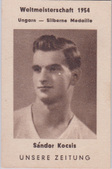
1aSándor Kocsis (HUN)
1954 Unsere Zeitung.
Sándor Kocsis was a prolific scorer and star of the “Mighty Magyars,” the Hungarian national team 42-7-1 between 1950 and 1956. According to the Elo-Rating system, that makes the Magyars the second-best national team in history. Kocsis was the top goal scorer in league play in Europe in both 1952 and 1954. For the national team, he score 75 times in 68 appearances for an incredible 1.10 goals/match. He won the Golden boot at the 1954 World Cup with 11 goals.
| 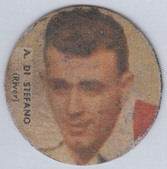
1bAlfredo Di Stéfano (ARG/SPA)
1940s Monte Cudine.
Considered one of the greatest players of all-time, Alfredo Di Stéfano won six league titles in Argentina and Columbia before moving to Spain. Between 1954 and 1964, Di Stéfano led Real Madrid to 8 league titles and an amazing 5 consecutive European Cups. He was awarded the Ballon d'Or in 1957 and 1959. Di Stéfano’s partnership with Ferenc Puskás is one of the most legendary in the history of football.
| 
1cFerenc Puskás (HUN)
1947 Nannina.
Imagine combining some of the best accomplishments of Kocsis with those of Di Stéfano and you have Ferenc Puskás. With the Mighty Magyars, Puskás 84 goals in 85 international matches, leading the team to just one loss in 6 years, the 1954 World Cup Finals, a match in which Puskas was injured yet still scored. At the club level, Puskás won 10 league titles (5 in Hungary and 5 with Real Madrid), three European cups, and 8 top individual scoring honors. In all, he scored 514 goals in 529 matches in Hungarian and Spanish leagues.
|
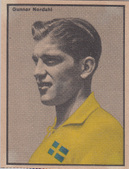
1dGunnar Nordahl (SWE)
1944 Dänemark Familie Journalens.
Arguably Sweden’s greatest plyer ever, Gunnar Nordahl was top scorer in Serie A a record 5 times despite only playing in Italy for 8 seasons. In fact, he is still the third-highest Serie A goal scorer of all time with 225 goals in 291 games, also making him the most efficient goal scorer of all-time in Serie A with 0.77 goals/match. He led Sweden to the gold medal at the 1948 Olympics. Unfortunately, because he played in Italy, he was denied the opportunity to play for the national team in any World Cup tournament.
| 
1eDidi (BRA)
1954 Radio Bandeirantes.
Didi is one of the greatest ever midfielders and perhaps Brazil’s best player during the 1950s. Didi’s greatest career moment came in the 1958 World Cup when he led Brazil to the title in dominating fashion and was named the tournament’s best player. He was also one of the best players in the 1957 and 1959 South American Championships. With Botafogo, he won the Campeonato Carioca (Rio State Championship) in 1957, 1961 and 1962. Didi had incredibly accurate passing, ball controlling, vision, great stamina and strength.
| 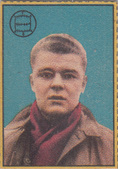
1fLászló Kubala (HUN)
1947 Nannina.
Kaiser Magazine ranks László Kubala the second-best all-time footballer from 1900 to 1968 and a 1999 fan poll declared him the best player to ever play for Barcelona. The Hungarian midfielder was the heart of Barcelona’s success in the 1950s when the club won four La Liga titles. Kubala is one of just a few players to play for three different national teams. He holds the record most goals in one Spanish La Liga game with 7 against Sporting Gijon in 1952.
|
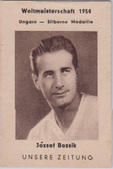
1gJózsef Bozsik (HUN)
1954 Unsere Zeitung.
Star midfielder of the Mighty Magyars, József Bozsik is generally regarded as the greatest deep-lying playmaker in history of European football. He won 101 caps with the Hungarian national team.
| 
1hNílton Santos (BRA)
1954 Radio Bandeirantes.
Regarded as one of the best defenders in the history of the game, Nilton Santos was a key player in the 1954, 1958 and 1962 World Cups. In the 1958 tournament, he famously dribbled the ball all the way down the field versus Austria, with Brazilian coach Vicente Feola yelling at him to pass the ball, and scored a goal. Santos won 75 caps with Brazil.
| 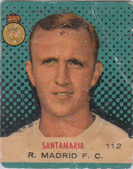
1iJose Santamaria (URU/SPA)
1957 Bruguera.
One of the all-time greatest central defenders, Jose Santamaria won five Uruguayan league titles with Nacional and six La Liga titles with Real Madrid. He is considered Real Madrid’s all-time best defender. Santamaria was capped 20 times by Uruguay and 16 by Spain, helping the former team finish fourth at the 1954 World Cup.
|
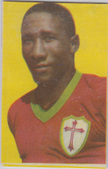
1jDjalma Santos (BRA)
1956 Idolos.
Considered to be one of the greatest right-backs of all time, Djalma Santos started for Brazil in 4 World Cups and was capped 98 times in all. He is one of only 3 players (along with Franz Beckenbauer and Phillip Lahm) to be named to three FIFA World Cup All-Star teams.
| 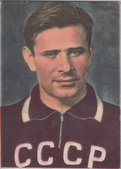
1kLev Yashin (RUS)
1959 Heinerle.
Lev Yashin is widely considered to be the greatest goalkeeper of all-time. He kept an incredible 270 clean sheets from approximately 420 career games (approximately 65 percent) and is the only goalkeeper to win European footballer of the year award. During his career, he had stopped 150 penalty kicks, the most all-time. Yashin appeared in four World Cups from 1958 to 1970. In 1994, FIFA established the Lev Yashin Award for the best goalkeeper in world cup final tournament.
| 
1lManager: Matt Busby (SCO)
1932 Godfrey Phillips BDV ‘Orange Borders’.
Matt Busby was the manager of Manchester United for 25 seasons and is known for successfully rebuilding the team following the Munich Air Disaster. Busby was first appointed as Man U.’s manager in 1945 and soon established himself as a successful manager of the club. His youthful team, nicknamed “Busby’s Babes” won three league titles in 1952, 1956 and 1957. In February of 1958, the plane carrying the team crashed, killing 8 players, including Duncan Edwards. Busby himself was read his last rites, but ultimately recovered. Following the crash, Busby successfully rebuilt the team. With George Best and others, United won league titles in 1965 and 1967 and won the European Cup in 1968.
|
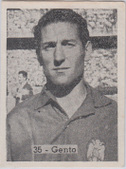
2aFrancisco Gento (SPA)
1952 Costas.
Outside-left Francisco “Paco” Gento won 12 La Liga titles with Real Madrid. He also won more European Cups than any other player, appearing in 8 European Cup finals, and winning 6. He was capped 43 times by Spain, including the 162 and 1966 World Cups.
| 
2bJuan Schiaffino (URU)
1950 Tinghälls.
One of the greatest Uruguayan footballers of all-time, inside-left Juan Schiaffino is well-known for scoring the first goal in the 1950 World Cup final match in which Uruguay upset Brazil. He was even better in the 1954 World Cup though Uruguay fell to Hungary. Schiaffino was more proficient as a creator and assister than a scorer. After winning three Uruguayan league titles with Peñarol, Schiaffino was purchased for a then-record fee by AC Milan with whom he would go on to win three league Serie A titles in 1955, 1957 and 1959.
| 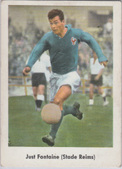
2cJust Fontaine (FRA)
1961 Heinerle.
French striker Just Fontaine holds the record for most goals scored in a single World Cup with an amazing 13 goals in the 1958 edition of the tournament. 4 of those goals were against the defending champion, West Germany. In club play, Fontaine scored 165 goals in 200 matches in Ligue 1 and won three league titles with Stade Reims. He scored 30 goals in just 21 caps for the French national team.
|

2dErnst Ocwirk (AUS)
c1952 Knübchen Schokolade. Considered one of the greatest central midfielders, Ernst Ocwirk captained the Austrian national team that finished in third place at the 1954 World Cup. He won five league titles with Austria Wien. He was capped 62 times by his country.
| 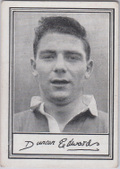
2eDuncan Edwards (ENG)
1954 Barratt (Series A2).
It is hard to believe there is a player on this list who died at the young age of 22. Duncan Edwards was the youngest player ever to play in England’s First Division. In his five seasons as one of “Busby’s Babes,” Edwards helped Manchester United win two league titles and reach the semi-finals of the European Cup. Edwards died in 1958 two weeks after sustaining critical injuries in the Munich Air Disaster.
| 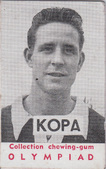
2fRaymond Kopa (FRA)
1956 Olympiad Chewing Gum.
Raymond Kopa was a renowned playmaker and a prolific scorer, known for his success with Real Madrid and with the French national team. At the club level, Kopa was a member of the dominant 1950s Real Madrid team that won three European Cups. With the French national team, Kopa and Just Fontaine led the team to a third-place finish at the 1958 World Cup. Kopa still holds the record for most all-time most assists in a single World Cup tournament with 9 in the 1958 tournament.
|
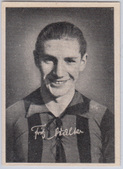
2gFritz Walter (GER)
1940 Kicker Bilderwirk.
Fritz Walter is one of the most beloved figures in German football, helping to revive a West German football that had been devastated by World War II. Walter was named captain of the 1954 West German team that would enter its first World Cup since the war. The team was comprised of amateurs since West Germany did not have a professional league yet. Walter was 33. Despite the long odds against them, West Germany won the tournament, defeating the Mighty Magyars of Hungary in the finals, a team that had not lost in 4 years. It was ironic for Walter since Hungarian prison guards had earlier saved his life by telling the Soviets that Walter, a prisoner at the end of the war, was not German. In 1956, Walter was able to repay the Hungarians by financially backing them when they were unable to return to Hungary following the Soviet crackdown in response to the Hungarian Uprising. Walter also captained West Germany in the 1958...
| 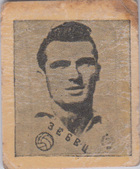
2hBranko Zebec (YUG)
1950s Yugoslavian.
One of the most versatile players of all-time, Branko Zebec played several positions but is most famous for playing center-back late in his career. Zebec played for the Yugoslavian national team in its quarterfinals losses to West Germany in both the 1954 and 1958 World Cup and its silver medal performance at the 1952 Olympics, losing in the final match to Hungary. In all, he was capped 65 times. At the club level, Zebec won three Yugoslavia Cups with Partizan Belgrade and one league title with Red Star Belgrade.
| 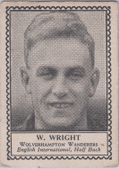
2iBilly Wright (ENG)
1947 Barratt.
Center-half Billy Wright was the first player in the world to win 100 caps and is tied with Bobby Moore for having won the most caps as team captain with 90. He captained England at the 1950, 1954 and 1958 World Cups. Wright won league titles with Wolverhampton Wanderers in 1954, 1958 and 1959 as well as the 1949 FA Cup.
|

2jVictor Rodriguez Andrade (URU/SPA)
1950 Tinghälls.
Right halfback for the Uruguayan national team that won the 1958 World Cup as well as the 1956 South American Championship, Victor Rodriguez Andrade is also the nephew of JL Andrade, the great 1920s midfielder. Victor Andrade helped the national team reach the semi-finals of the 1954 World Cup and won two Uruguayan league championships with Peñarol in 1953 and 1954.
| 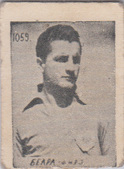
2kVladimir Beara (YUG)
1950s Yugoslavian Issue.
One of the greatest goalkeepers of all-time, Vladimir Beara won seven league titles in Yugoslavian League in just ten years (1950-1960). In 1950, he led Hajduk Split to an undefeated season, the only time any team had accomplished this in Yugoslavia League. With Yugoslavia, Beara won the silver medal at the 1952 Olympics, losing to Hungary in the final match, and reached the quarter-finals at the 1954 and 1958 World Cups.
| 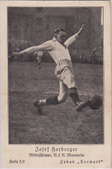
2lManager: Josef "Sepp" Herberger (GER)
1927 Zuban.
Sepp Herberger is famous for rebuilding the West German national team after World War II and surprising the world by winning the 1954 World Cup. West Germany won the final match versus the juggernauts of the tournament, the Hungarian national team, in what is now known as the “Miracle of Bern.” West Germany finished in third place in the 1958 World Cup under Herberger. His legacy is not without controversy as he was a member of the Nazi Party.
|
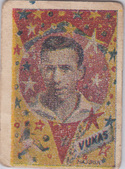
3aBernard Vukas (YUG)
1963 Yugoslavian Issue.
Great at both assisting and scoring, Bernard Vukas won three Yugoslavian League titles, including Hajduk Split’s undefeated season (Vladamir Beara was the goalkeeper). Vukas scored 300 goals for Hajduk Split. Vukas was a member of the Yugoslavian national team that reached two consecutive Olympic finals.
| 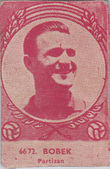
3bStjepan Bobek (YUG)
1958 Yugoslavian Issue.
All-time record goal scorer for the former Yugoslavia, Stjepan Bobek represented his country in two world cups and was a key member of the team which reached two consecutive Olympic finals. The great Ferenc Puskás strived to copy Bobek’s game. With FK Partizan, he won two Yugoslavian League titles and four Yugoslavian Cups.
| 
3cJohn Charles (WAL)
1951 Godfrey Philipps.
Considered by some to be the greatest all-around footballer to come from Britain, John Charles was equally adept at center-forward or center-back. With Juventus, he won three Serie A titles and two Italian Cups. Charles scored 93 goals in five years in Italy, leading the league with 28 in the 1957-58 season. Dubbed the “Gentile Giant”, he was never cautioned or sent off during his entire career, due to his philosophy of never kicking or intentionally hurting opposing players.
|
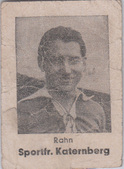
3dHelmut Rahn (GER)
1950 Toto Gum.
Helmut Rahn is a German legend due to the “Miracle of Bern” in which the German national team, comprised of amateur players, defeated the Hungarian national team in the final match of the 1954 World Cup. The West German team were themselves surprised to be in the final and were playing a team that had not lost a match in 4 years. Down 0-2 in the match, Rahn assisted with the first goal and scored the last two to give West Germany the win. With Rahn, West Germany also reached the semi-finals of the 1958 World Cup. After the 1958 tournament, Rahn had the third highest goal total in World Cup history and was the only player to score 4 or more goals in two tournaments.
| 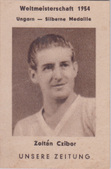
3eZoltan Czibor (HUN)
1954 Unsere Zeitung.
An important member of the “Magical Magyars,” winners at the 1952 Olympics and runners-up at the 1954 World Cup, striker Zoltán Czibor scored 17 times during his career for the Hungarian national side. At the club level, he won 3 Hungarian Championships with two different clubs and won two La Liga championships with Barcelona.
| 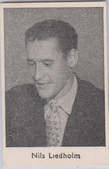
3fNils Liedholm (SWE)
1948 Sparbanken.
Voted best Swedish player of the 20th Century by the readers of Sweden’s largest newspaper, Nils Liedholm was one-third of the famous Swedish trio “Gre-No-Li” that won four league titles with AC Milan. With the Swedish national team, the talented midfielder won a gold medal at the 1948 Olympics and second place at the 1958 Olympics.
|

3gZlatko Čajkovski (YUG)
1956 Yugoslavian Issue.
Defensive midfielder Zlatko Čajkovski was a key member of the Yugoslavian national side that finished second at both the 1948 and 1952 Olympic Games. He was capped 55 times by Yugoslavia.
| 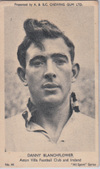
3hDanny Blanchflower (IRE)
1954 A&BC "All Sport".
Right half Danny Blanchflower has been ranked the greatest player in Tottenham Spurs’ history. As the club’s captain, he led the Spurs to the first Premiere League and Cup double of the 20th century. Blanchflower was named the English FWA Footballer of the Year in 1958 and 1961.
| 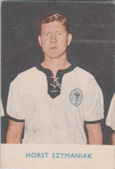
3iHorst Szymaniak (GER)
1958 Alfa.
One of the best German footballers of the late 1950s/early 1960s, defensive midfielder Horst Szymaniak was rated “world class” by Kicker sports magazine between 1957 and 1961. He was capped 43 times by West Germany and was a member of the 1958 and 1962 World Cup squads.
|

3jRobert Jonquet (FRA)
1950s Cantaloup.
An integral part of France’s 1950s World Cup teams, central defender Robert Jonquet was capped 58 times by his national team. At the club level, he won five French championships and appeared in two European Cup finals.
| 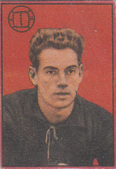
3kWalter Zeman (AUS)
1947 Naninna.
One of the best goalkeepers of the 1950s, Walter Zeman won 8 Austrian league championships and one Austrian cup. Capped 41 times by Austria, he helped the national side reach the semi-finals at the 1954 World Cup.
| 
4aJulinho (BRA)
1954 Radio Bandeirantes.
Brazilian footballer Júlio Botelho (Julinho) is considered s one of the top all-time wingers . He led Fiorentina to the Italian title in 1956. Capped 17 times by Brazil, Julinho scored twice in the 1954 World Cup.
|

4bGiampiero Boniperti (ITA)
1947 Naninna.
Playing his entire career with Juventus, forward Giampiero Boniperti led the club to five Serie A tiles and two Italian Cups. Along with John Charles and Omar Sivori, Boniperti formed the “Magical Trio,” which dominated Italian football in the late 1950s.
| 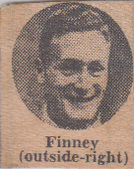
4cTom Finney (ENG)
1946 Daily Mail Supplement.
The English Football Writers’ Association Footballer of the Year for 1954 and 1957, winger Tom Finney made 569 appearances during 14 seasons for Preston North End. He scored 30 times for England in 76 appearances.
| 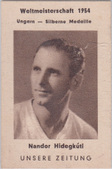
4dNandor Hidegkuti (HUN)
1954 Unsere Zeitung.
A member of the “Magical Magyars,” Nándor Hidegkuti scored a hat-trick against England at Wembley Stadium in 1953. In all, he scored 39 times in 69 appearances for the Hungarian national side. As a member of MTK Budapest, he won three Hungarian titles. Hidegkuti was also a successful manager, guiding Fiorentina to win the 1960-61 European Cup Winners’ Cup and Győri ETO FC to the semi-finals at the 1964-65 European Cup.
|
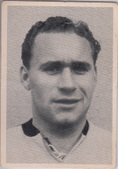
4eHerbert Erhardt (GER)
1954 OK Kaugummi.
One of the leading German defenders after WWII, Herbert Erhardt played as side back, center half and wing half, mostly known for his strength and hard tackling. He was a stand-out at the 1954 World Cup, helping West Germany reach the semi-finals. Erhardt went on to captain the national team on 16 occasions between 1959 and 1962.
| 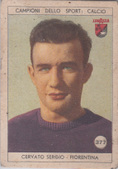
4fSergio Cervato (ITA)
1950 Omaggio.
Defender Sergio Cervato captained the 1955-56 Fiorentina team that lost only one game and is considered one of the best Italian clubs of all time. With Cervato, Fiorentina was Serie A runner-up the following three seasons. He also won two Serie A titles with Juventus.
| 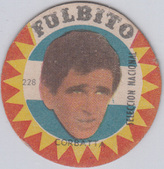
4gOmar Corbtta (ARG)
1959 Fulbito.
Many historians rank Omar Corbatta as the best Argentine right winger of all-time. Between 1958 and 1965, he won four Argentine Primera División titles with Racing Club and Boca Juniors. He was a member of the Argentina national teams that won the 1957 and 1959 Copa América tournaments. Overall, Corbatta scored 18 goals in 43 caps for Argentina.
|
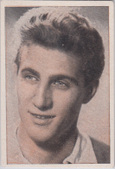
4hHans Schäfer (GER)
1954 Kiddy.
Outside left Hans Schäfer was a key member of the West German side that won the 1954 World Cup. He was also a member of the national side that participated in the 1958 and 1962 World Cups. Named German Footballer of the Year in 1963 at age 25, Schäfer led his club 1. FC Köln to German championships in 1962 and 1964.
| 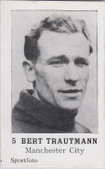
4iBert Trautmann (ENG)
1954 Sportfoto.
German goalkeeper and Manchester City legend Bert Trautmann served as a paratrooper in the German air force during WWII. He was captured by the English, taking to a prisoner-of-war camp in England and was eventually released after the war. He stayed in England where he signed with Manchester City in 1949. He would stay with the club until 1964, making 545 appearances in all. He was named FWA Footballer of the Year due to his performance in the 1956 FA Final. In that match, Trautmann he sustained a serious neck injury with 17 minutes remaining yet stayed in the game, making crucial saves to preserve a victory for his blub. Following the game, x-rays revealed he had been playing with a broken neck.
| 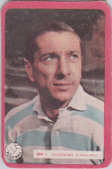
4jThadée Cisowski (FRA)
1960 Miroir Sprint.
French striker Thadée Cisowski is one of the all-time goalscorers in Championnat de France. He led Ligue 1 in scoring in 1956, 1957 and 1959. Over his career, he scored 206 goals in 286 league appearances, fourth on the all-time list for Lique 1.
|
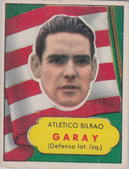
4kJesús Garay (SPA)
1952 Ases Del Fútbol.
Center-back Jesús Garay won three Spanish Cups and a league title with Athletic Bilbao. He was capped 29 times by Spain.
| 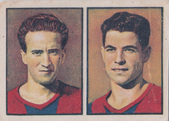
4lEstanislau Basora (SPA)
1949 Gallina Blanca.
Striker Estanislau Basora was a key member of the legendary Barcelona front line that included Basora, László Kubala and César. The club won four La Liga titles with Basora between 1948 and 1953. He scored 13 times in 22 appearances for the Spanish national side.
| 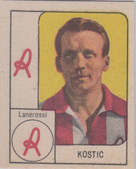
4mBora Kostić (YUG)
1961 Nannina.
Serbian Borivoje "Bora" Kostić was a prolific left winger, one of finest Yugoslav players of his generation, and was well known for powerful shot and free kick ability. He is the all-time leading scorer for Red Star Belgrade with 158 goals. Kostić scored 26 goals in 33 appearances for the Yugoslavia national team.
|
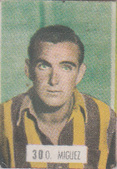
4nÓscar Miguez (URU)
1949 Goles y Dobles.
Uruguay's all-time record World Cup goalscorer, Óscar Miguez scored 5 times in the 1950 World Cup to win the Silver Boot. At the club level, he excelled at Peñarol,where he scored 107 goals in 137 matches, yielding him an excellent average of 0.78 goals per match.
| |